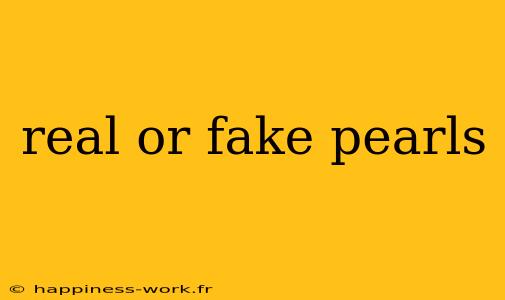Pearls have long been cherished for their elegance and beauty. However, with the rise of imitation pearls in the market, distinguishing between real and fake pearls has become essential for buyers. In this article, we’ll explore the key differences between real and fake pearls, as well as tips and techniques to help you identify them. We’ll also discuss the various types of pearls available, their value, and how to care for them properly.
What Are Real Pearls?
Real pearls are formed through a natural process involving mollusks, such as oysters and mussels. When an irritant, like a grain of sand, enters the shell, the mollusk secretes layers of nacre, which over time forms a pearl. Real pearls can be categorized into three main types:
- Natural Pearls: Formed in the wild without human intervention, these are extremely rare and often very valuable.
- Cultured Pearls: Created by inserting a bead or piece of tissue into a mollusk, which then produces nacre around it. These are more common and can be found in various types, such as Akoya, Tahitian, and South Sea pearls.
- Freshwater Pearls: Grown in freshwater mussels and often more affordable, these pearls can be found in a variety of shapes and sizes.
Why Is It Important to Know the Difference?
Understanding the difference between real and fake pearls is crucial for several reasons:
- Investment: Genuine pearls can be significant investments, while fake pearls typically hold little value.
- Quality: Real pearls tend to have a unique luster and texture that cannot be replicated by synthetics.
- Care and Maintenance: Authentic pearls require specific care methods to maintain their beauty, whereas fake pearls are generally more resilient.
Identifying Real vs. Fake Pearls
1. The Tooth Test
One popular method to determine authenticity is the "tooth test." When you rub a pearl against the edge of your tooth, a real pearl feels gritty, while a fake pearl will feel smooth. This test works because real pearls have a crystalline structure due to layers of nacre, while synthetic pearls are often made from plastic or glass.
2. The Luster Test
Real pearls exhibit a depth of luster that is hard to find in imitations. To test this, observe the pearls under good lighting. Authentic pearls will reflect light in a soft, glowing manner, while fake pearls will often have a shiny, plastic-like surface that lacks depth.
3. Check for Imperfections
Real pearls often have unique shapes and slight imperfections, while fake pearls tend to be uniform in size and shape. Examine your pearls closely; natural variations are a good sign of authenticity.
4. The Weight Test
Real pearls are denser than synthetic ones. If you have a similar-sized fake pearl and a real pearl, you’ll notice the real pearl feels heavier.
5. Seek Professional Help
If you're still unsure, consider consulting a professional jeweler. They have specialized tools and expertise to identify pearls accurately.
Caring for Real Pearls
Proper care is essential to maintain the beauty of real pearls. Here are a few tips:
- Avoid Contact with Chemicals: Perfumes, hairsprays, and cleaning products can damage the nacre of pearls.
- Store Properly: Keep pearls in a soft pouch or lined box to avoid scratches.
- Clean Gently: Use a soft, damp cloth to clean pearls after wearing them. Do not soak them in water or use abrasive cleaners.
Conclusion
Whether you’re a pearl enthusiast or a first-time buyer, knowing how to distinguish between real and fake pearls is essential for making informed decisions. By using techniques like the tooth test, luster test, and professional assessment, you can ensure that you are purchasing genuine pearls.
Additional Resources
If you're interested in learning more about pearls, consider reading books on gemstone identification or taking a course on jewelry appraisal. Such resources can further deepen your understanding and appreciation of these beautiful gems.
References
This article is inspired by the informative content from WikiHow, and we've expanded on the concepts to provide additional insights and practical examples for readers.
Feel free to reach out if you have further questions about pearls or need personalized advice on purchasing!
